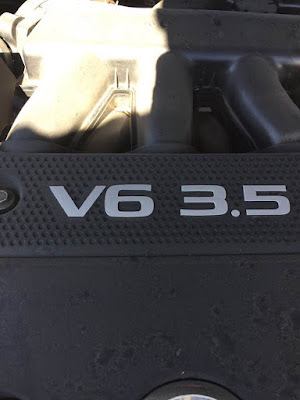Back in high school my buddy Rob had one of these and I was embarrassed at the time to admit that I really liked it. Well, for the record - I liked driving it; save for AMC Pacer's, these things were about as dorky as cars got back then. Yes - this was worse than my dreadful Comet. Rob's Pinto was a vomit green on vomit green 1974 while our blue on blue subject here is a 1975 model.
Rob's Pinto was nimble and sports car maneuverable thanks to light weight, diminutive size and its rack and pinion steering; a first in an American car. It had a light clutch and an easy to engage four speed; well, easy to engage after you hunted down the shifter that shook and bounced around in its hole on top of the hump.
It bounced around so much because of the "2300" engine Rob's car had just like our subject here has. It provided decent poke and despite it having a state of the art overhead cam, it was a real paint shaker; I always thought it was running on three cylinders. Nope - in the days before balance shafts, that's the way big fours ran. It also sounded like a dinky tractor and that made his car come across for exactly what it was - a cheap economy car. Starting in 1974 Ford began offering a 60 degree, 2.8 liter V-6 that was a bastion of civility and refinement compared to these engines. Remarkably, this engine lived on in one form or another through the 1997 model year.
Back then, though, we were never fearful of being rear ended and having the car explode because, frankly, I don't even remember hearing about these things blowing until at least the mid 1980's if not later. I could be wrong - it was a long time ago. In any event, an August 1977 investigative article called "Pinto Madness" was published in the not for profit, independent newspaper "Mother Jones" and it highlighted the cars tendency to burst into flames in rear end collisions because of serious design flaws. To make matters worse, the Ford Motor Company knew of the flaws and determined it was less expensive to pay out millions in wrongful death lawsuits suits than to fix the design problem.
That design problem stemmed from an attempt to maximize interior space while keeping vehicle weight to no more than 2,000 pounds. To do so, engineers placed the gas tank between the differential and rear bumper rather than on top of the differential; doing that would have compromised interior room. While it was not out of the ordinary to place the gas tank where they did, what was out of the ordinary was that Ford didn't reinforce the rear of the car.
There was some back and forth back then about how safe a vehicle needed to be in the event of a rear end accident, strict federal regulations regarding such didn't going into affect until 1977, but Ford tested the car themselves when it was under development and found it leaked fuel in 8 of the 11 rear end crashes they conducted. And...they literally did nothing about it save for offering a voluntary recall where they put a plastic shield in between the bumper and gas tank.
I have no idea if Rob's Pinto, a hand me down from his father, had the retrofit shield installed or not. Something tells me it didn't knowing his father who wasn't exactly a "Father of the Year" kind of guy. Besides, who believes they're ever going to have an accident that results in their car bursting into flames even if the car is a well documented fire trap?
As far as we were concerned, not knowing anything about exploding gas tanks and what not, ignorance was bliss.



























